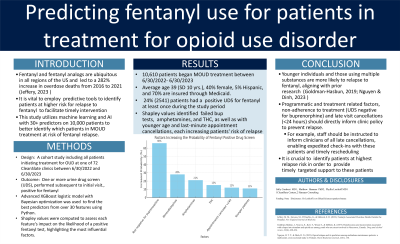Back

(66) Predicting Fentanyl Use for Patients in Treatment for Opioid Use Disorder
Saturday, April 6, 2024
9:45 AM – 1:15 PM


Matthew Hanauer, MPA, PhD
Senior Data Scientist
CleanSlate Centers, North Carolina
Phyllis Losikoff, MD
Medical Dir Research
CleanSlate Centers, Massachusetts- CJ
Claudie Jimenez, MD
Chief Medical Officer
CleanSlate Centers, Tennessee
Presenter(s)
Non-presenting author(s)
Background & Introduction: Fentanyl is a synthetic opioid 50-100 times more potent than morphine, and deaths from its use almost quadrupled from 2014 to 2021 (CDC, 2021). Despite increasing awareness of its dangers, fentanyl use is rising, fueling the urgency to understand the underlying factors predicting its use. Various elements, ranging from socioeconomic status to prior substance abuse, influence the likelihood of fentanyl use; however, these analyses only included a limited number of predictors with small sample sizes (Douglas, 2022). This study aims to identify these predictors through a multi-faceted approach, employing machine learning algorithms and explainable artificial intelligence with over 30 predictors and 10,000 patients. Our research offers insights to inform targeted interventions and preventive measures.
Methods: We aimed to identify factors associated with fentanyl use among patients enrolled in treatment for opioid use disorder (OUD). We performed a cohort study utilizing electronic medical records, including all patients initiating treatment for OUD at CleanSlate between 6/30/2022 and 6/30/2023. Our outcome was one or more positive fentanyl urine drug screens after their initial visit during the study period. We identify factors associated with fentanyl use by conducting a repeated cross-validation XGBoost logistic model with Bayesian hyperparameter optimization to identify the best-fitting model. We included over 30 features in the initial model. From that model, we calculated Shapley values, which identify the unique contribution of each feature on each patient’s predicted outcome value, similar to parameter estimates in a regression analysis. We present features making the largest contribution to the outcome.
Results: 10,610 patients started OUD treatment during the 12-month study period. 24% (n = 2541) tested positive for fentanyl on at least one urine drug screen. The sample was 40% female, and the average age of participants was 39, sd = 11 years. Of the factors modeled, patients for whom urine drug screens were positive more frequently than average for benzodiazepines, amphetamines, and THC had a higher probability of a positive fentanyl drug screen, 28%, 21%, and 15%, respectively. Younger patients had an 11% higher risk of returning to fentanyl use, and patients who canceled their appointments < 24 hours before had a 12% higher risk of returning to fentanyl use. Finally, patients who more often test negative for buprenorphine are 66% more likely to test positive for fentanyl.
Conclusion & Discussion: Younger patients and those with polysubstance use were found to be at higher risk of relapse to fentanyl use. The association of these patient characteristics with relapse to fentanyl use is consistent with previous observations in smaller samples assessing initiation or relapse to opioid use. (Goldman-Hasbun et al., 2019; Nguyen & Dinh, 2023).
Unique to our findings are the factors associated with the treatment program, notably non-adherence to medication (buprenorphine) and late cancellations. These programmatic or treatment-related factors can directly inform clinic policy to prevent relapse. For example, administrative staff can be instructed to inform clinicians of all late cancellations, enabling clinicians and peer support staff to check in with patients and ensure an expedited make-up appointment is scheduled.
The high potency and swift onset of action associated with fentanyl raises the likelihood of overdose-related fatalities. To reduce the risk of fatal outcomes among our patients, addiction medicine clinicians must be able to identify individuals at the highest risk of relapse to offer them more tailored support.
References: Jeffery, M. M., Stevens, M., D’Onofrio, G., & Melnick, E. R. (2023). Fentanyl-Associated Overdose Deaths Outside the Hospital. New England Journal of Medicine.
Goldman‐Hasbun, J., Nosova, E., Kerr, T., Wood, E., & DeBeck, K. (2019). Homelessness and incarceration associated with relapse into stimulant and opioid use among youth who are street‐involved in Vancouver, Canada. Drug and alcohol review, 38(4), 428-434.
.
Nguyen, H. T. T., & Dinh, D. X. (2023). Opioid relapse and its predictors among methadone maintenance patients: a multicenter, cross-sectional study in Vietnam. Harm Reduction Journal, 20(1), 136.
Methods: We aimed to identify factors associated with fentanyl use among patients enrolled in treatment for opioid use disorder (OUD). We performed a cohort study utilizing electronic medical records, including all patients initiating treatment for OUD at CleanSlate between 6/30/2022 and 6/30/2023. Our outcome was one or more positive fentanyl urine drug screens after their initial visit during the study period. We identify factors associated with fentanyl use by conducting a repeated cross-validation XGBoost logistic model with Bayesian hyperparameter optimization to identify the best-fitting model. We included over 30 features in the initial model. From that model, we calculated Shapley values, which identify the unique contribution of each feature on each patient’s predicted outcome value, similar to parameter estimates in a regression analysis. We present features making the largest contribution to the outcome.
Results: 10,610 patients started OUD treatment during the 12-month study period. 24% (n = 2541) tested positive for fentanyl on at least one urine drug screen. The sample was 40% female, and the average age of participants was 39, sd = 11 years. Of the factors modeled, patients for whom urine drug screens were positive more frequently than average for benzodiazepines, amphetamines, and THC had a higher probability of a positive fentanyl drug screen, 28%, 21%, and 15%, respectively. Younger patients had an 11% higher risk of returning to fentanyl use, and patients who canceled their appointments < 24 hours before had a 12% higher risk of returning to fentanyl use. Finally, patients who more often test negative for buprenorphine are 66% more likely to test positive for fentanyl.
Conclusion & Discussion: Younger patients and those with polysubstance use were found to be at higher risk of relapse to fentanyl use. The association of these patient characteristics with relapse to fentanyl use is consistent with previous observations in smaller samples assessing initiation or relapse to opioid use. (Goldman-Hasbun et al., 2019; Nguyen & Dinh, 2023).
Unique to our findings are the factors associated with the treatment program, notably non-adherence to medication (buprenorphine) and late cancellations. These programmatic or treatment-related factors can directly inform clinic policy to prevent relapse. For example, administrative staff can be instructed to inform clinicians of all late cancellations, enabling clinicians and peer support staff to check in with patients and ensure an expedited make-up appointment is scheduled.
The high potency and swift onset of action associated with fentanyl raises the likelihood of overdose-related fatalities. To reduce the risk of fatal outcomes among our patients, addiction medicine clinicians must be able to identify individuals at the highest risk of relapse to offer them more tailored support.
References: Jeffery, M. M., Stevens, M., D’Onofrio, G., & Melnick, E. R. (2023). Fentanyl-Associated Overdose Deaths Outside the Hospital. New England Journal of Medicine.
Goldman‐Hasbun, J., Nosova, E., Kerr, T., Wood, E., & DeBeck, K. (2019). Homelessness and incarceration associated with relapse into stimulant and opioid use among youth who are street‐involved in Vancouver, Canada. Drug and alcohol review, 38(4), 428-434.
.
Nguyen, H. T. T., & Dinh, D. X. (2023). Opioid relapse and its predictors among methadone maintenance patients: a multicenter, cross-sectional study in Vietnam. Harm Reduction Journal, 20(1), 136.
Learning Objectives:
- Recognize substances (e.g., benzodiazepines, amphetamines, THC) strongly correlated with fentanyl use to inform targeted screening and interventions.
- Learn to apply machine learning algorithms like XGBoost to identify key predictors influencing fentanyl use in a diverse patient population.
- Assess behavioral and demographic factors in fentanyl use to tailor educational programs and integrate behavioral health into treatment plans.
